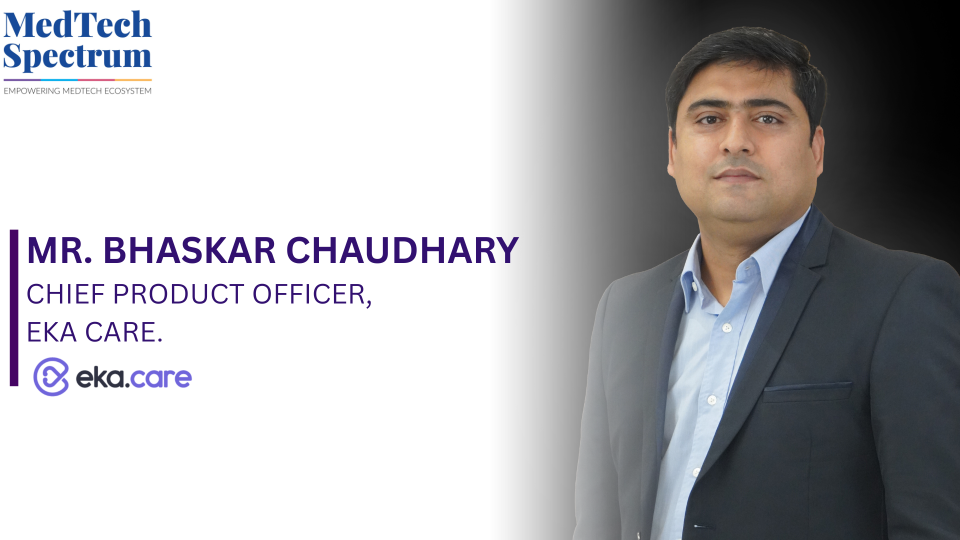
In India’s rapidly evolving digital health landscape, one of the most significant challenges for clinicians is the burden of documentation. Doctors often spend as much time entering patient data as they do interacting with patients, creating a trade-off that negatively affects both the quality of care and physician well-being. To address this issue, Eka Care, a pioneer in developing India-centric digital health solutions, has introduced EkaScribe an AI-powered clinical scribing assistant designed to alleviate this burden.
EkaScribe is trained to understand the Indian healthcare context and is optimized for real-world consultations. It captures and structures medical conversations in real time, allowing doctors to redirect their focus back to their patients. With multilingual capabilities, compliance with the Ayushman Bharat Digital Mission (ABDM), and seamless integration with Electronic Medical Records (EMR) and Electronic Health Records (EHR), EkaScribe aims to transform workflows in clinics and hospitals across the country.
In this conversation with Medtech Spectrum, Bhaskar Chaudhary, Chief Product Officer at Eka Care, discusses the motivations behind the development of EkaScribe, how it distinguishes itself from global competitors, and its potential to shape the future of healthcare delivery in India and beyond.
What gaps in clinical practice or doctor workflows motivated you to build EkaScribe, and how do you see it transforming doctor-patient interaction?
The biggest gap we saw was the burden of documentation on doctors. On average, clinicians spend almost as much time entering data as they do seeing patients, which takes away from direct engagement and often leads to burnout. With EkaScribe, we wanted to free doctors from the pen & paper/keyboard and allow them to focus entirely on the patient. By capturing and structuring consultation notes in real time, EkaScribe shifts the dynamic from a “doctor writing/typing” interaction to a “doctor listening and engaging” interaction—restoring empathy and trust at the center of care.
How does EkaScribe differentiate itself from other AI-driven documentation assistants in terms of accuracy, adaptability to clinical settings, and real-time performance?
EkaScribe has been trained specifically on Indian clinical data and healthcare contexts, which gives it unmatched accuracy in local medical terms, drug names, and consultation styles. Unlike generic transcription tools, it doesn’t just convert speech to text—it understands clinical context and structures notes directly into SOAP/EMR-ready formats. Our models are optimized for low-latency, real-time performance, ensuring doctors get immediate outputs even in resource-constrained environments. Plus, its adaptability allows it to work across specialties, from general practice to super-specialties, with minimal training required.
India’s healthcare system is linguistically diverse. How challenging was it to build multilingual capability into EkaScribe, and what impact does this inclusivity have on its adoption across regions?
Building multilingual capability was one of the toughest challenges—we had to account for not just different languages but also mixed speech patterns, where doctors often switch between English and a regional language mid-consultation. Our models are trained on large datasets of such code-mixed medical conversations, which makes EkaScribe highly robust in real-world Indian consultations. This inclusivity has been critical for adoption—doctors in Tier 2 and Tier 3 cities feel comfortable using the tool in the language they naturally consult in, which accelerates trust and usage across regions.
Seamless integration with EMRs/EHRs is often a barrier for AI tools. How does EkaScribe ensure interoperability across different platforms, and how important is ABDM compliance for scaling adoption?
We built EkaScribe as an API-first solution with flexible SDKs, making integration with existing EMRs/EHRs frictionless. Its output is structured, standardized, and can be mapped easily into any clinical workflow. Being ABDM-compliant adds another layer of trust and interoperability—doctors and hospitals adopting EkaScribe don’t need to worry about compliance overheads, as the tool is designed to plug seamlessly into ABDM-linked health systems. For us, ABDM compliance isn’t just about regulation—it’s about ensuring EkaScribe can scale nationally and align with India’s digital health mission.
Beyond saving doctors' time, what early feedback have you received from clinicians using EkaScribe regarding accuracy, patient engagement, or improved care delivery?
Clinicians consistently tell us that EkaScribe makes their consultations feel “lighter”—less stressful and more patient-focused. Early users highlight three major benefits:
Accuracy: Doctors find that the AI captures even complex medical terminology with minimal correction required.
Patient engagement: Patients feel the doctor is “listening more,” since they aren’t distracted by writing/typing.
Care delivery: Doctors report being able to capture more medical data points per consultation without compromising quality, thus generating detailed notes for medico-legal and follow-up needs.
Looking ahead, how do you envision expanding EkaScribe’s capabilities, whether through advanced analytics, integration with diagnostic tools, or global market entry?
EkaScribe has demonstrated the ability to relieve physicians of administrative burdens, allowing them to reclaim valuable time with patients. Physicians and nurses today operate within digital ecosystems that manage scheduling, billing, pharmacy orders, and diagnostic workflows. EkaScribe’s future value lies in acting as a bridge between clinical conversations and operational systems, ensuring that critical information flows into the right channels without disrupting the provider’s focus on patients. For instance, when a physician dictates a discharge summary, EkaScribe could structure that narrative so the HMIS recognizes discharge status, generates billing codes, and alerts pharmacy or laboratory departments as needed. Similarly, voice-captured instructions like “schedule follow-up in two weeks” could trigger the HMIS appointment module directly, reducing manual entry. By embedding itself into the hospital’s operational fabric, EkaScribe evolves from a documentation assistant to a workflow intelligence partner, ensuring that every spoken instruction translates into actionable hospital tasks. Future versions of EkaScribe could highlight deviations from defined protocols, prompt for risk factors or comorbidities that may otherwise go unrecorded, and flag inconsistencies that might affect compliance. Beyond individual encounters, aggregate patient data can provide deeper insights. Global leaders in medical scribing—particularly in the United States and Australia—are already piloting predictive analytics that aim to reduce errors and elevate the quality of care. By contextualizing such tools for the Indian setting, EkaScribe can not only match but potentially lead this global evolution.